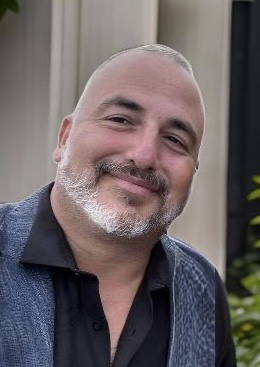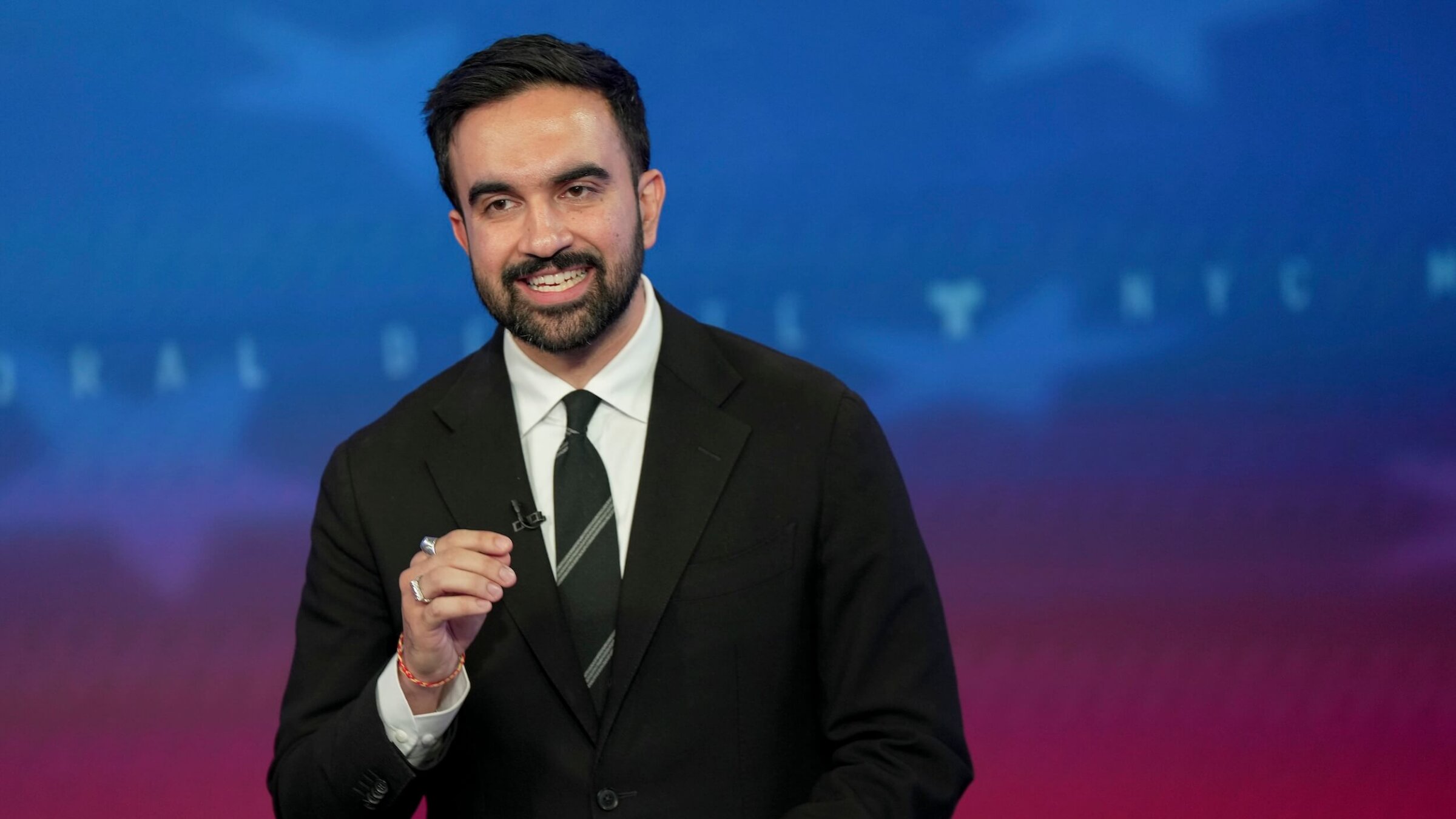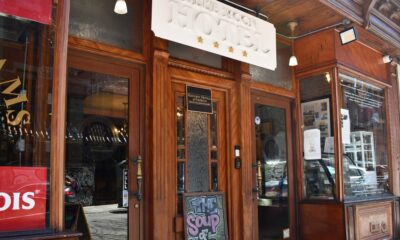Features
Tafsik: Canadian organization created in wake of October 7 has played leading role in combating anti-Israel hatred

By BERNIE BELLAN It was prior to an event featuring Col. John Spencer speaking here on September 11 that we first became of something called “Tafsik.” We had received an email from whatever Tafsik was, inviting us to attend the Spencer event, but there was absolutely no information contained within that email explaining what Tafsik was.
Then, at the actual event, there was the logo for Tafsik emblazoned on a screen overlooking the stage at the Berney Theatre where Spencer spoke. Granted, there were logos for other organizations as well, but the Tafsik logo was larger than any of the others.
We were intrigued by the notion that an organization about which we knew nothing had been involved in bringing a notable expert on urban warfare to our city – and who has established a fierce reputation as a defender of the Israel Defence Forces, so we contacted Adam Levy, Publlc Relations and Communications Director for the Jewish Federation, to ask him whether he knew anything about Tafsik?
Adam said he didn’t and referred us to the organization’s website.
When we sent an email to Tafsik directly, asking who was behind them and what they were all about, we received a rather generic reply containing information that was already available on its website, but which left us even more intrigued as to who was behind it:
“Tafsik organization emerged resolutely from the tragedy of October 7th, dedicated to combating Jew Hatred in Canada and beyond. By forging alliances with diverse communities—including Iranian, Indian, Christian, Yazidi, Venezuelan, and many other groups—Tafsik is uniting voices against Jew hatred on a global scale. The organization hosts significant events featuring prominent figures such as Douglas Murray, Gad Saad, Hillel Fuld, and Colonel John Spencer, to illuminate the challenges faced by Israel and the Jewish community worldwide. Additionally, Tafsik is leveraging cutting-edge AI technology to combat Jew Hate more effectively. As one of the fastest-growing grassroots organizations in Canada, Tafsik is committed to fostering understanding and solidarity in the fight against hatred.”

Then, on September 30, we received yet another email from Tafsik, this time advertising the upcoming appearance in Winnipeg (on October 22) of well-known Columbia professor Shai Davidai.
If you don’t know who Shai Davidai is, he came to prominence soon after October 7 last year when Columbia University in New York City became a hotbed of antisemitism, where Jewish students and professors alike were being intimidated into silence – and fear for their physical safety, by fiercely antisemitic mobs that were being allowed to run rampant on that university’s campus.
A Youtube video appeared of Davidai speaking to Jewish students at Columbia, in which he spoke quite emotionally about how “unsafe” he felt at Columbia – and it quickly went viral. (You can watch that video at https://www.youtube.com/watch?v=VPVe2CsBqmM or simply by entering “Shai Davidai” in the Youtube search bar.)
So – two well-known speakers – John Spencer and Shai Davidai, both sponsored by an organization called Tafsik – about which we still knew very little. We were determined to find out who was behind Tafsik. We sent yet another email to the organization, but this time we were rewarded with a very expansive reply – this time from the organization’s founder directly, someone by the name of Amir Epstein.
Here is what Epstein wrote to us, in response to our suggestion that the original email we had received from Tafsik explaining what the organization wall all about was rather generic in its content:

“I apologize for the ‘generic’ explanation as to what Tafsik Organization is all about and our accomplishments. I hope my overview below satisfies any curiosity and questions you may have. I’m always happy to answer any specific questions I didn’t touch on.
“I cofounded Tafsik Organization after October 7th in response to the complicity I witnessed in the communities I have dedicated my life to defending. Suddenly, our community found itself isolated. I recognized that the rise of antisemitism in Canada had eroded our institutions, such as our universities, school boards, unions, media, and politics, all leading to a troubling apathy toward the horrific attacks on our people in Israel.
“As a law graduate who briefly worked in criminal law and previously owned a successful tech company in the food and beverage industry, I felt compelled to take action. I realized our community faced a serious existential threat. I approached my tech colleague, Bryan Lipovetsky, who had built my companies framework and website, and together we launched Tafsik Organization. Initially, we acted quickly, driven by a desperate need to help, although we were still defining our purpose and how best to combat the overwhelming hate directed at Canadian Jews.
“Our focus became twofold: building alliances and leveraging technology to combat antisemitism. In February, we launched TECAH (The Emergency Coalition Against Hate) alongside the remarkable Douglas Murray in Toronto, quickly becoming Canada’s fastest-growing grassroots ally-building organization. We have formed strong connections with the Indian and Iranian communities, commemorating significant events such as the anniversary of the Air India bombing, the murder of Mahsa Amini, and the genocide in Bangladesh. We have also engaged with various communities, including Venezuelan, Afghan, Arab, Chinese, and Black communities, and are working closely with Sheikh Mirza Ismail on reunifying Yazidi families still in refugee camps in northern Iraq with their relatives in Canada.
“Additionally, we have built meaningful relationships with leaders in politics, including some of the top politicians in our country. We understand the critical role their government positions play in protecting our community.
“We have hosted numerous sold-out events featuring prominent speakers like Douglas Murray, Gad Saad, Hillel Fuld, and Colonel John Spencer, with an upcoming event featuring Shai Davidai. These events aim to present the truth to diverse communities within our city.
“On the technology front, we are actively seeking funding to develop AI software capable of identifying individuals and accounts online that glorify terrorism. This technology will assess account histories, such as comments, likes, and posts, to evaluate potential radicalization and threats. Our goal is not commercialization but to provide law enforcement with tools to prevent real danger and violence against our community and others.
“In response to the overwhelming amount of antisemitic graffiti in Toronto, we are developing a new app called ‘Graffiti Watch’ that will map instances of hate speech in public spaces, empowering our community to take action against it. Graffiti Watch will be free to download.
“While our primary focus is on ally building and technology initiatives, we occasionally respond to urgent needs outside these pillars. For instance, this past June, we received a request via WhatsApp to help children from Kibbutz Kfar Szold, who were under missile attack from Hezbollah. When a major organization in Toronto declined to support this initiative, we launched a GoFundMe campaign and successfully raised more than we needed. As a result, we flew 15 children to Canada, where they attended Camp Northland and enjoyed a week of fun activities, including visits to Canada’s Wonderland, Niagara Falls, Ripley’s Aquarium, and a shopping spree. We also organizers a big dance party for the children, fostering new friendships with children from our community. Again, all free of charge. We are not a business. We are a non profit, and soon to be charity. Everything we have done has been self funded by me and a little money from donations, with exception to the Israeli kids who we brought with donations.
“This past year has been incredibly successful, exceeding our expectations. We now have just under 10,000 subscribers on our mailing list and a growing social media presence, including followers like Douglas Murray, Aviva Klompas, The Imam of Peace, Eylon Levy, and Colonel John Spencer to name just a few. These leaders recognize us as a driving force in Canada, dedicated to protecting our community and helping those in need.
“I hope this clarifies who we are as an organization and what we aspire to do.”
We thanked Amir Epstein for his quite expansive explanation, not only about how Tafsik came about, but who he is. We asked whether he’d be willing to send us a photo of himself and he readily agreed.
By the way, we’re not sure if there are still tickets available for Shai Davidai’s appearance here on October 22, but if you’re interested in attending you could try this link: www.tafsik.com/shai-winnipeg
Features
Guest Article — A Canadian Jewish Traveller’s Money Playbook: Smarter FX & Safer Digital Finance for Israel Trips and Beyond
Written for readers of jewishpostandnews.ca
Whether you’re flying to Israel for a simcha, helping a student with a gap year, supporting family abroad, or making a donation to a cause you care about, the way you move money matters. Small choices around foreign exchange (FX), card settings, and digital security can quietly cost—or save—you hundreds of dollars per trip. This guest guide keeps things practical and non-hyped, with steps you can use right away.
1) Foreign Exchange: Focus on the all-in cost, not just the posted rate
Most leaks happen in three places: spreads (the markup over interbank), fees(ATM/operator/bank), and terminal settings (dynamic currency conversion, or DCC).
Winnipeg-to-Israel routine (works for most routes):
1. Always pay in the local currency. In Israel, choose ILS at the terminal; in the U.S. leg of a connection, choose USD. Decline DCC—letting the terminal convert to CAD usually costs more.
2. Separate rails by purpose.
○ Everyday spending: use a low/no-FX-fee card.
○ Larger cash or transfers: get a quote from a specialist and compare with your bank’s total cost (rate plus fees).
3. Stage big conversions. If the rate feels jumpy, split a large exchange into two or three tranches to average your price.
4. Carry a small cash float. Enough for taxis, tips, markets, and rural stops—then default to card for everything else.
5. Log your effective rate. Screenshot ATM and card receipts so you can see the actualCAD cost later.
Starting point to benchmark retail quotes: check posted rates, ID requirements, and pickup logistics via currency exchange in Ontario (useful if you or your student connect through Toronto/YYZ or spend time in the GTA before departure).
2) Israel-specific tips (simchas, tours, and longer stays)
● Hotels & car rentals: expect hefty holds on credit cards; keep extra available limit to avoid declines.
● Transit & payments: most urban vendors take cards, but small kiosks and markets may prefer cash; keep some small ILS notes.
● Receipts for donations & tours: store PDFs in one folder (cloud + offline) with a simple naming format (YYYY-MM-DD_vendor_amount). It saves time at tax season and for warranty/claim issues.
3) Tuition, program fees, and family support
Moving four- or five-figure sums? The spread matters more than you think.
● Shop the spread: get at least two quotes on the same day (bank vs. specialist).
● Confirm the lock: ask how long the rate-hold window lasts and the funds-received cut-off to avoid re-quotes.
● Proof of payment: save wire confirmations and the beneficiary’s receipt; mismatched names or references can delay admission or housing.
4) Tzedakah and cross-border donations (general guidance)
● Ask for the right receipt: Canadian tax receipts require a registered Canadian charity number; many Israel-based organizations partner with Canadian affiliates—ask before you give.
● Card vs. wire: cards are fast but may carry higher total cost on large gifts; wires are slower but can be cheaper for size.
● Record-keeping: store the acknowledgement email, PDF receipt, and card/wire confirmation together.
(This section is informational—always seek professional tax advice for your situation.)
5) If you hold a little crypto (optional)
Crypto isn’t for everyone, but if you already hold some—or your student does—treat it like an operations problem: keys, backups, and off-ramps.
Minimum viable safety
● Self-custody for long-term funds: use a hardware wallet; keep a small hot-wallet only for spending.
● Never store seed phrases in email or cloud notes. Write them down and secure them (consider splitting and sealing).
● On/off-ramp drill: before you travel, do a tiny test withdrawal to confirm access and speed; save TX IDs and exchange statements.
If you’re scaling exposure or want a security-first setup (custody architecture, recovery run-through, incident response), consider a session with crypto investment consultants.
6) One-page checklists you can save
Travel Day (Israel or U.S. connection)
● Card set to pay in local currency (decline DCC)
● Small test purchase completed on arrival
● Shortlist of ATMs with known operator fees
● Cash envelope for day-one expenses
● Offline copies of bookings + insurance on your phone
Large FX Transfer (tuition/deposit/donation)
● Two quotes captured (bank vs. specialist)
● Rate-lock window and cut-off confirmed
● Screenshots with timestamps saved
● Wire confirmation + beneficiary receipt filed
Crypto Hygiene (if applicable)
● Hardware wallet initialized; seed written and stored safely
● 2FA keys offline; password manager updated
● Test withdrawal completed; TX IDs logged
● Quarterly: verify balances, rotate credentials, re-test recovery
jewishpostandnews.ca serves readers with local, diaspora, and Israel coverage—readers who routinely plan Israel trips, support causes, and help students abroad. Practical money ops reduce friction on exactly those journeys.
Bottom line (and a small disclaimer)
You don’t need to “time the market.” Use the cheapest reliable rail for each job, avoid DCC, stage large conversions, and keep clean records. If crypto is in your mix, run it with production-grade safety. This article is informational only, not financial, tax, or investment advice; consult qualified professionals for your circumstances.
Features
Why some Satmar Hasidic leaders endorsed Zohran Mamdani as mayor, stunning many Jewish voters

By Jacob Kornbluh November 2, 2025
This story was originally published in the Forward. Click here to get the Forward’s free email newsletters delivered to your inbox.
A surprise endorsement of Zohran Mamdani by a faction of the Satmar Hasidic community has set off a firestorm within the community, exposing sharp internal divisions about the Democratic nominee struggling to earn the trust of many Jews in the race for New York City mayor.
On Sunday, Rabbi Moshe Indig, a political leader of the sect led by Rabbi Aaron Teitelbaum from Kiryas Joel and known as the Ahronim, publicly declared his support for Mamdani at a meeting he organized in Williamsburg.
But within hours, three prominent leaders of the Ahronim sect issued a joint statement rejecting the move and announcing their own endorsement of former Gov. Andrew Cuomo, who was the community’s preferred candidate during the Democratic primary.
Indig, a leading political figure in the Ahronim camp who had praised Mamdani earlier in the campaign as “very nice, very humble” and “not antisemitic,” has not commented publicly since the backlash unfolded.
Why it matters
For Mamdani, who has sought to defuse criticism of his anti-Israel statements through quiet outreach to Haredi leaders, the turmoil reflects both his progress and the limits of his effort.
The approximately 80,000 voters in Brooklyn’s Haredi communities, where rabbinic dictates about ballot choices lead to a reliable bloc of support, are particularly sought after by candidates. The Satmar community is known for its staunchly anti-Zionist religious ideology.
If Mamdani, a democratic socialist and strident critic of Israel who leads by double digits according to recent polls, wins Tuesday’s election, it would mark the third consecutive mayoral race in which Ahronim’s political arm has demonstrated its political influence by backing the eventual winner, while other Hasidic blocs supported rival candidates.
In 2021, they endorsed Eric Adams over Andrew Yang, who was favored by most leading Hasidic sects. And in 2013, they backed Bill de Blasio, who narrowly avoided a runoff in the Democratic primary by just 5,000 votes, while the Zalonim and other groups supported Bill Thompson, then seen as the frontrunner.
The move to endorse Mamdani came days after Satmar, including the larger sect led by Rabbi Zalmen Teitelbaum from Williamsburg and known as the Zalonim, declared that they would not endorse any candidate for mayor while also condemning the “fear campaign” and attacks on Mamdani. They also met with Cuomo on Wednesday night, accompanied by Mayor Eric Adams, but ultimately declined to back him.
In an open letter to their followers published on Wednesday, the Satmar leadership highlighted Mamdani’s gestures that specifically addressed their concerns. They noted that the Democratic nominee has said he would work to protect Hasidic yeshivas that face scrutiny for failing to meet state education standards and promised that Hasidic families would benefit from his proposals to expand affordable housing and establish universal childcare.
If Mamdani wins, he would become the first Muslim mayor of New York City, home to the largest concentration of Jews in the U.S.
Cuomo still enjoys broad support among Jewish voters, who make up an estimated 10% of the general election electorate. A recent Quinnipiac poll of 170 Jewish voters showed Cuomo with 60% of their support and Mamdani with 16%, while a separate Marist poll of 792 likely voters — including an 11% sample of Jewish voters — found Cuomo with 55% and Mamdani at 32% among Jewish respondents.
Cuomo also has the backing of most Orthodox groups that helped swing the 2021 mayoral race for Adams, including the Flatbush Jewish Community Coalition and the two largest voting blocs in Borough Park — Bobov and Belz. The remaining 25 Hasidic sects and yeshivas in Borough Park have declined to issue a recommendation in the current race.
This story has been updated to include news of a rift in the community after the Mamdani endorsement.
Jacob Kornbluh is the Forward’s senior political reporter. Follow him on Twitter @jacobkornbluh or email kornbluh@forward.com.
This story was originally published on the Forward.
Features
The Technology Behind Real-Time Streaming in Live Dealer Casinos

Live dealer casino games from top-tier providers, such as Evolution Gaming and Pragmatic Play, are experiencing unprecedented popularity. If you’re curious about how these games function and which technologies make these games possible, you’ve come to the right place.
On this page, we will be revealing several key insights into some of the most highly sophisticated real-money betting games available in the iGaming industry.
Anyone who is interested in exploring these cutting-edge games can find a regularly updated list of the most reputable Canadian online casinos that feature top-notch live dealer games on various trusted iGaming review sites.
What are Live Dealer Games at Online Casinos?
Live dealer games at online casinos are broadcast in real-time to your preferred Wi-Fi/internet-connected PC or mobile device, and they feature actual croupiers (human being dealers) to present the action to you.
While some live dealer gameplay originates from traditional land-based casinos, the majority are streamed from specialized online studios designed to replicate the atmosphere of a real casino.
In contrast to computer-generated games such as slots, table games, scratch cards, bingo, lottery-style games, crash games, and video poker, which rely on Random Number Generators (RNGs) to determine outcomes, live dealer games do not utilize RNGs.
However, with that said, live dealer TV game shows with second-screen bonus rounds and live dealer online slot machines DO use frequently tested RNGs to produce the fair and realistic outcomes/results.
This means that live dealer games offer an experience that closely resembles playing in a physical casino.
Which key technologies underpin live dealer casino games?
Live dealer games utilize various advanced technologies to ensure smooth operations across web browsers and modern devices, including smartphones, tablets, laptops, and desktop computers.
The essential technologies employed by online casino software providers and iGaming operators in developing and maintaining live dealer games enable players to enjoy an immersive, engaging, and realistic experience.
The key technologies include:
- Live streaming capabilities
- High-definition (HD) audio and visual features
- Multiple HD cameras
- Optical character recognition (OCR) technology
- Game control units (GCU)
- Instant messaging (IM) text chat features
Let’s now quickly explore what some of these technologies entail.
Multiple HD-ready cameras capture video of live dealer hosts as they deal and present the action in a casino-themed environment. This footage is streamed live over the internet from various angles.
OCR technology scans physical objects, such as cards and chips, transmitting this information to the graphical overlay visible during gameplay, which essentially converts game data into a digital format.
The live streaming capabilities, along with immersive chat features, enable players to view the action, join in live rounds, and communicate with both dealers and fellow players, which significantly enhances the social experience of online gambling.
Final thoughts
To sum up, live dealer technology has elevated online casinos to new heights. To play these games, players must be at least 18 or 19 years old (depending on where you live). For example, in Ontario, you must be at least 18 years old to play, but in other provinces, such as British Columbia, the minimum age requirement stands slightly lower at 18.
In the United States, you must be 21 years old to play live dealer and computer-generated online casino games in the real money mode. If you choose to engage, remember to gamble responsibly and play only on reputable sites operated by trusted entities.
Some of today’s hottest games to check out from leading software providers in 2025 include Live Crazy Balls, Fortune Roulette Live, Live Crazy Pachinko, Live XL Roulette, and Busted or Bailed Live. Additionally, popular titles like Monopoly Live and Live Sweet Bonanza Candyland are also a couple of epic hit titles that are worth exploring.
On a final note, it’s highly recommended to establish either a daily, weekly, or monthly deposit limit to help you stay within your spending budget. You can also set win/loss limits, spending caps, or session time reminders to help keep things safe and fun.




